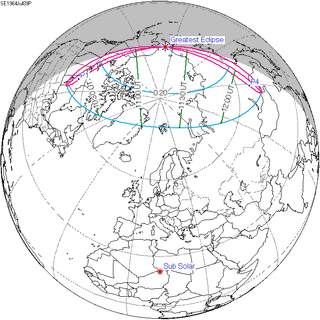A partial solar eclipse occurred on July 9, 1964. A solar eclipse occurs when the Moon passes between Earth and the Sun, thereby totally or partly obscuring the image of the Sun for a viewer on Earth. A partial solar eclipse occurs in the polar regions of the Earth when the center of the Moon's shadow misses the Earth.
| Solar eclipse of July 9, 1964 | |
|---|---|
| Type of eclipse | |
| Nature | Partial |
| Gamma | 1.3623 |
| Magnitude | 0.3221 |
| Maximum eclipse | |
| Coordinates | 67°36′N 172°54′W / 67.6°N 172.9°W |
| Times (UTC) | |
| Greatest eclipse | 11:17:53 |
| References | |
| Saros | 155 (3 of 71) |
| Catalog # (SE5000) | 9429 |
Related eclipses edit
Solar eclipses of 1961–1964 edit
This eclipse is a member of a semester series. An eclipse in a semester series of solar eclipses repeats approximately every 177 days and 4 hours (a semester) at alternating nodes of the Moon's orbit.[1]
| Solar eclipse series sets from 1961 to 1964 | ||||||
|---|---|---|---|---|---|---|
| Descending node | Ascending node | |||||
| Saros | Map | Gamma | Saros | Map | Gamma | |
| 120 | 1961 February 15 Total |
0.88302 | 125 | 1961 August 11 Annular |
-0.88594 | |
| 130 | 1962 February 05 Total |
0.21066 | 135 | 1962 July 31 Annular |
-0.11296 | |
| 140 | 1963 January 25 Annular |
-0.48984 | 145 | 1963 July 20 Total |
0.65710 | |
| 150 | 1964 January 14 Partial |
-1.23541 | 155 | 1964 July 09 Partial |
1.36228 | |
| Partial solar eclipses of June 10, 1964 and December 4, 1964 belong in the next lunar year set. | ||||||
References edit
- ^ van Gent, R.H. "Solar- and Lunar-Eclipse Predictions from Antiquity to the Present". A Catalogue of Eclipse Cycles. Utrecht University. Retrieved 6 October 2018.
External links edit
- Earth visibility chart and eclipse statistics Eclipse Predictions by Fred Espenak, NASA/GSFC
